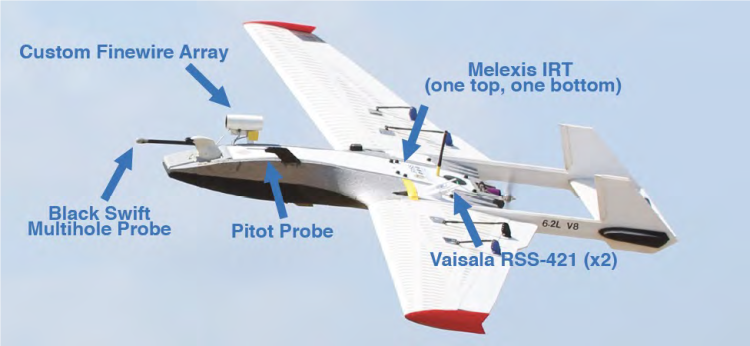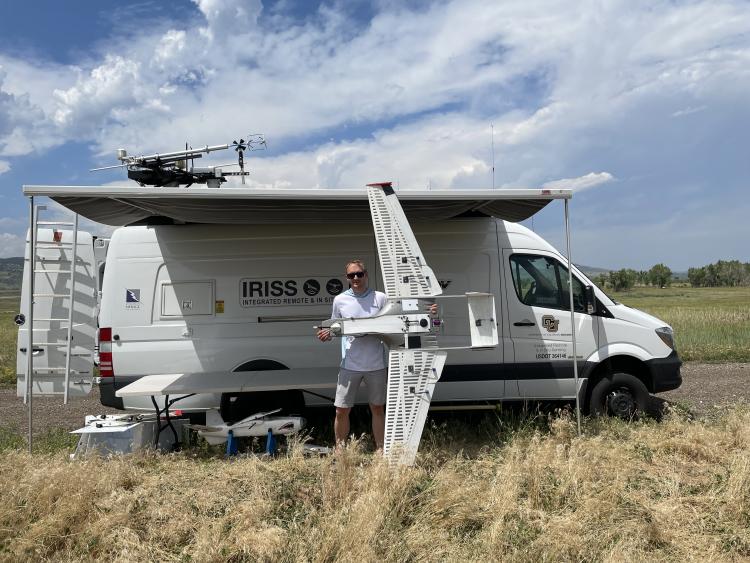RAAVEN
The RAAVEN has been instrumental in collecting atmospheric measurements in the lower atmosphere in various environments. The RAAVEN has logged hundreds of flight hours supporting major field campaigns including TORUS 2019-2022 (NSF), ATOMIC 2020 (NOAA), MOSAIC 2020 (NSF), TRACER 2022 (DOE), TORUS-LItE 2023 (NSF), and ICECHIP 2025 (NSF). The RAAVEN has also been used to provide datasets in support of weather forecasting and monitoring.
The standard RAAVEN UAS is equipped with two Vaisala RSS 421 to collect temperature, pressure and relative humidity (thermodynamic variables) and a custom multi-hole probe to derive three-dimensional winds. The RAAVEN uses the Cube Orange+ flight controller with an inertial navigation system that provides aircraft position and orientation. Additional instrumentation includes a fine-wire array for high-resolution measurements of fluctuations in airspeed and static temperature, two Melexis infrared thermometers for energy-flux measurements, and the Portable Optical Particle Spectrometer (POPS), developed in the NOAA Chemical Sciences Laboratory, that reports particle size and number concentrations of aerosols. The RAAVEN airframe is customizable with the potential to integrate a range of additional payloads within size, weight, and power constraints.
RAAVEN Specifications
Platform Specifications
Type Fixed-Wing
Wingspan size 2.3 meters
Base Configuration Weight 14.3 lbs
Speed Range 17 m/s cruise; 20 m/s (dash)
Build Materials EPP foam, Coroplast, carbon fiber
Operating Conditions*
Max sustained wind speed aloft 40 m/s
Max ground wind (gust or sustained) 15 m/s
Flight ceiling 5.5 km MSL
Operational altitude range (typical) 30-760 m
Endurance Up to 2.5 hr
Measurement Specifications
Thermodynamic variables:
Temperature (accuracy, resolution) ±0.3 K, ±0.01 K
Relative Humidity (accuracy, resolution) ±3%, 0.1%
Pressure (accuracy, resolution) ±0.2 mbar, ±0.01mbar
Wind (3D):
Speed ±0.25 m/s
Direction ±0.5°
Data rate 10 Hz
*Flight operations are also contigent on FAA and agency specific policies and regulations.

Standard instrumentation for the RAAVEN

Publications regarding the accuracy of RAAVEN measurements:
de Boer, G., B. Butterworth, J. Elston, A. Houston, E. Pillar-Little, B. Argrow, T. Bell, P. Chilson, C. Choate, B. Greene, A. Islam, R. Martz, M. Rhodes, D. Rico, M. Stachura, F. Lappin, S. Whyte, and M. Wilson, 2024: Evaluation and Intercomparison of Small Uncrewed Aircraft Systems Used for Atmospheric Research, Atmos. Ocean. Tech., 41, 127–145, https://doi.org/10.1175/JTECH-D-23-0067.1
And in field campaigns:
Lappin, F., G. de Boer, P. Klein, J. Hamilton, M. Spencer, R. Calmer, A. Segales, M. Rhodes, T. Bell, J. Buchli, K. Britt, E. Asher, I. Medina, B. Butterworth, L. Otterstatter, M. Ritsch, B. Puxley, A. Miller, A. Jordan, C. Gomez-Faulk, E. Smith, S. Borenstein, T. Thornberry, B. Argrow, and E. Pillar-Little, 2023: Data collected using small uncrewed aircraft system during the TRacking Aerosol Convection Interactions ExpeRiment (TRACER), Earth Sys. Sci. Data, 16, 2525–2541. https://doi.org/10.5194/essd-16-2525-2024
de Boer, G., R. Calmer, G. Jozef, J. Cassano, J. Hamilton, D. Lawrence, S. Borenstein, A. Doddi, C. Cox, J. Schmale, A. Preußer, and B. Argrow, 2022: Observing the Central Arctic Atmosphere and Surface with University of Colorado Uncrewed Aircraft Systems, Nature Sci. Data., 9, 439, https://doi.org/10.1038/s41597-022-01526-9
Frew, E. W., Argrow, B., Borenstein, S., Swenson, S., Hirst, C. A., Havenga, H., and Houston, A., 2020: Field observation of tornadic supercells by multiple autonomous fixed-wing unmanned aircraft, J. Field Robot., 37, 1077-1093, https://doi.org/10.1002/rob.21947
Kristen L. Axon, Adam L. Houston, Conrad L. Ziegler, Christopher C. Weiss, Erik N. Rasmussen, Michael C. Coniglio, Brian Argrow, Eric Frew, Sara Swenson, Anthony E. Reinhart, and Matthew B. Wilson, The Potential Roles of Preexisting Airmass Boundaries on a Tornadic Supercell Observed by TORUS on 28 May 2019, Monthly Weather Review, Vol. 152, No. 1, pp. 97–121, https://doi.org/10.1175/MWR-D-23-0007.1
Matthew B. Wilson, Adam L. Houston, Conrad L. Ziegler, Daniel M. Stechman, Brian Argrow, Eric W. Frew, Sara Swenson, Erik Rasmussen, and Michael Coniglio, 2023: Environmental and Storm-Scale Controls on Close Proximity Supercells Observed by TORUS on 8 June 2019, Monthly Weather Review, Vol. 151, No. 12, pp. 3013-3035, https://doi.org/10.1175/MWR-D-23-0002.1
de Boer, G., S. Borenstein, R. Calmer, C. Cox, M. Rhodes, C. Choate, J. Hamilton, J. Osborn, D. Lawrence, B. Argrow and J. Intrieri (2022): Measurements from the University of Colorado RAAVEN Uncrewed Aircraft System during ATOMIC, Earth System Science Data, Vol. 14, 19–31, https://doi.org/10.5194/essd-14-19-2022

